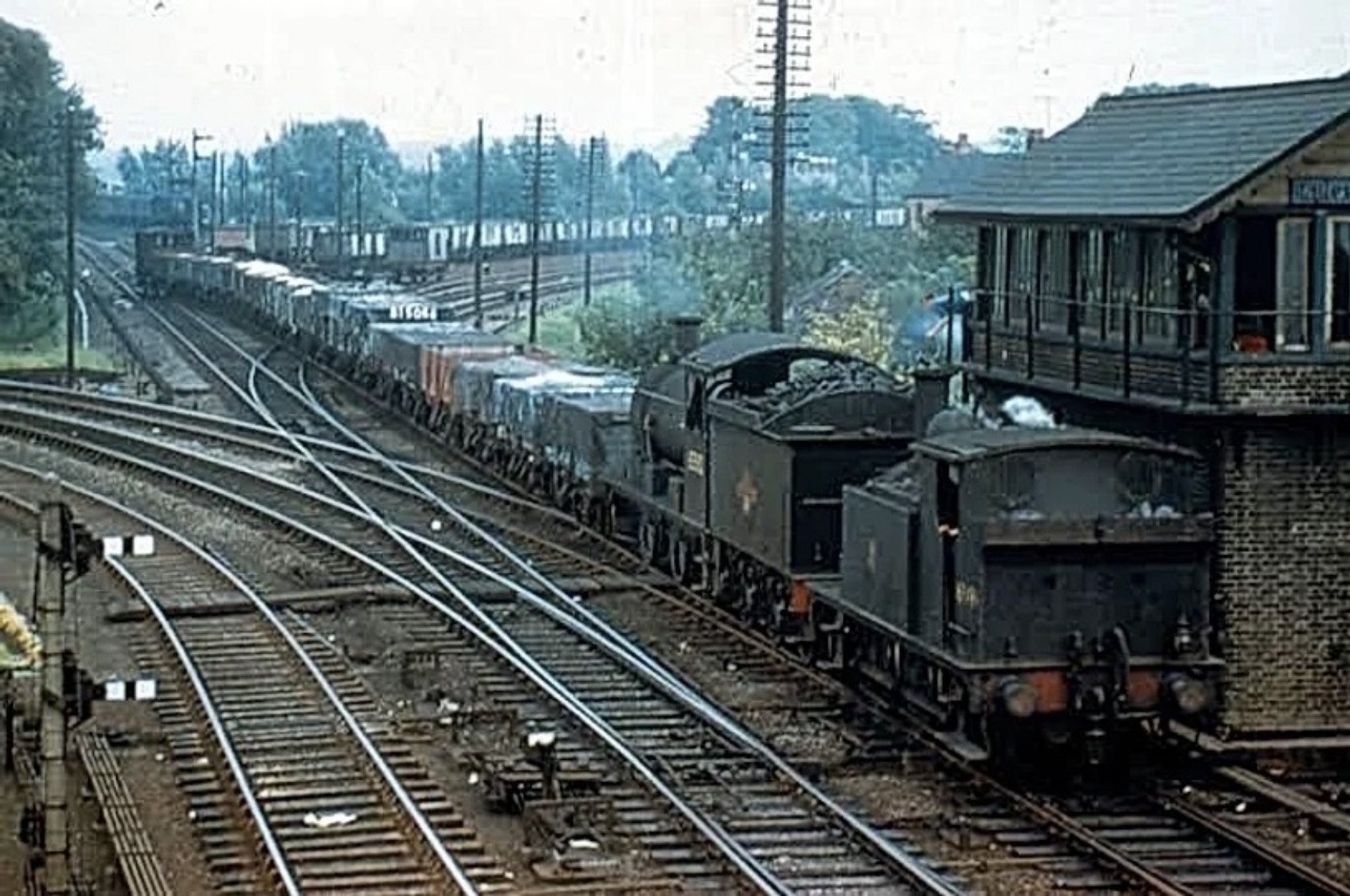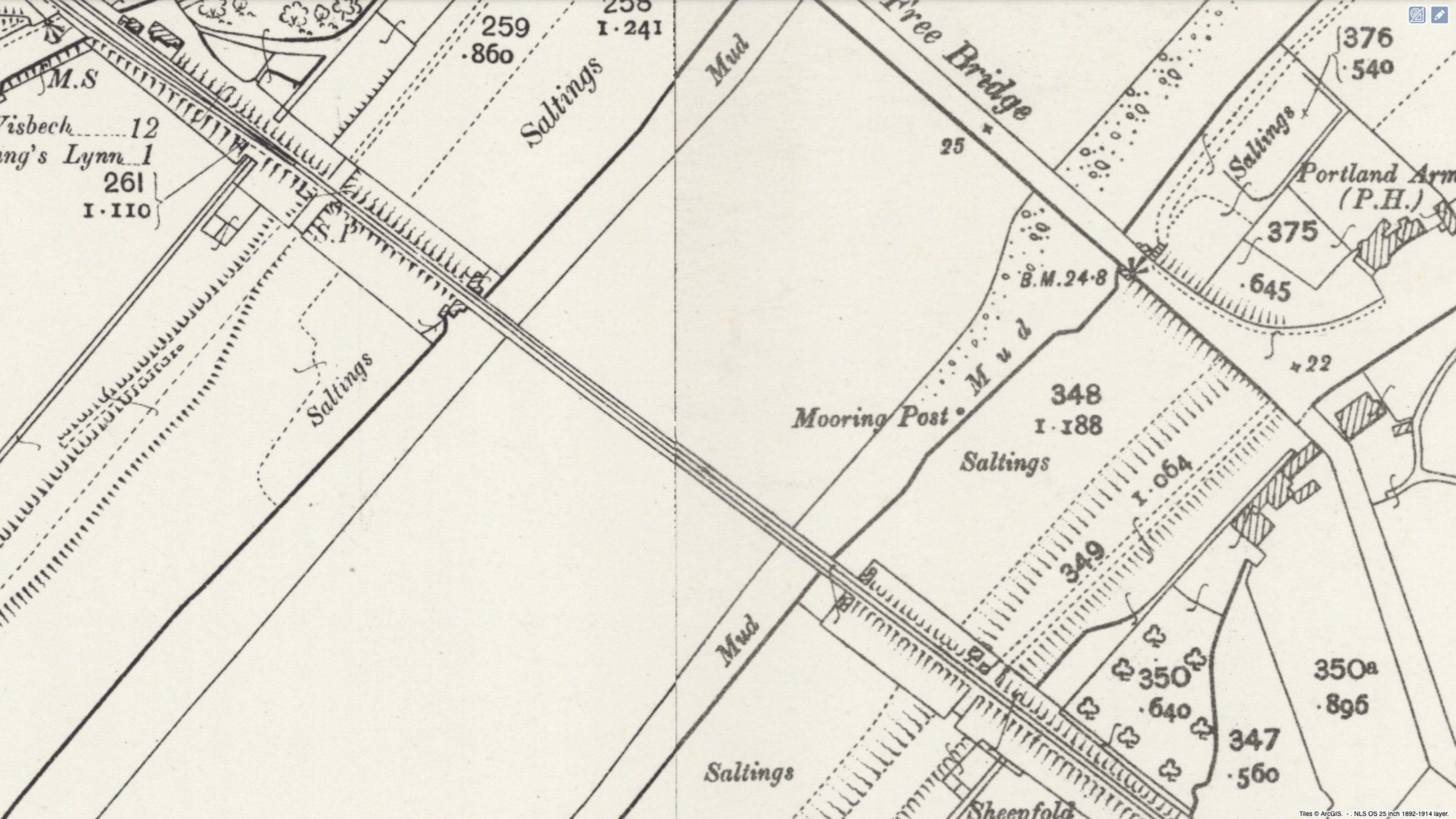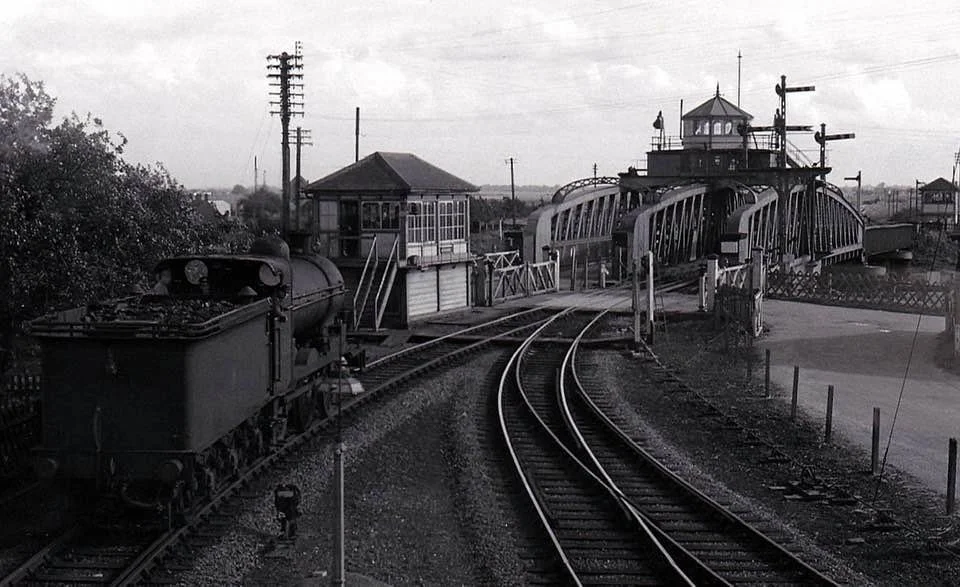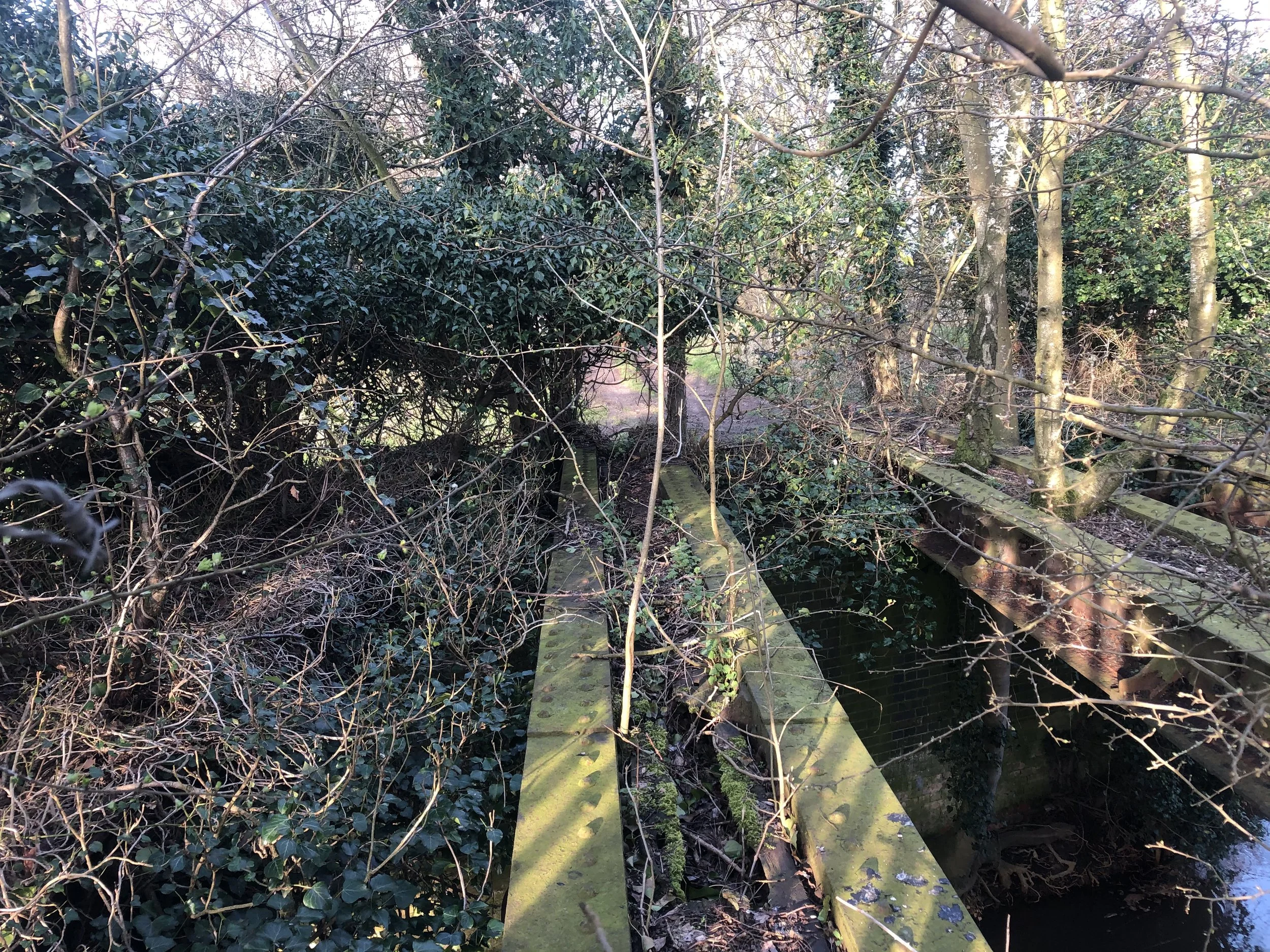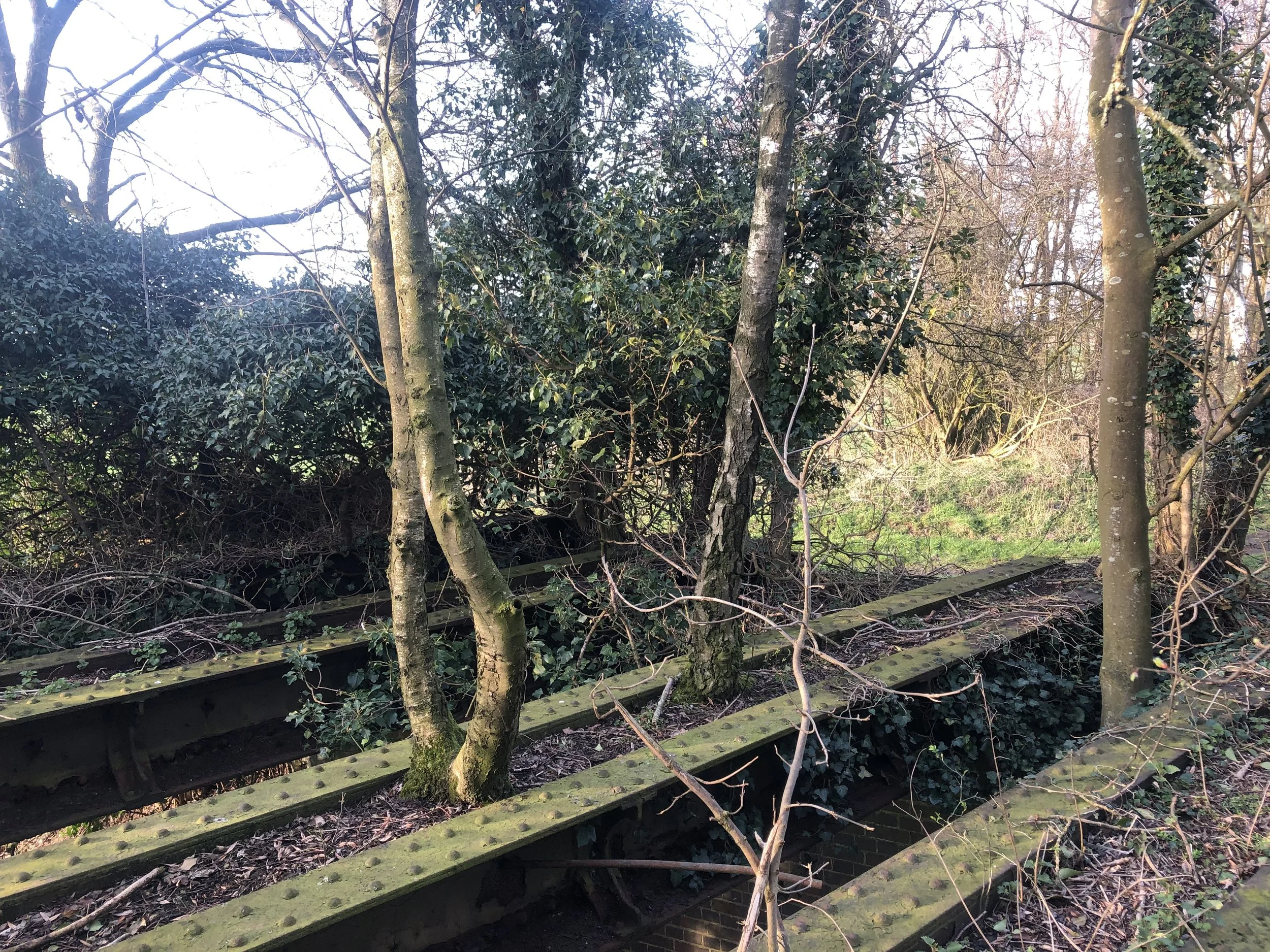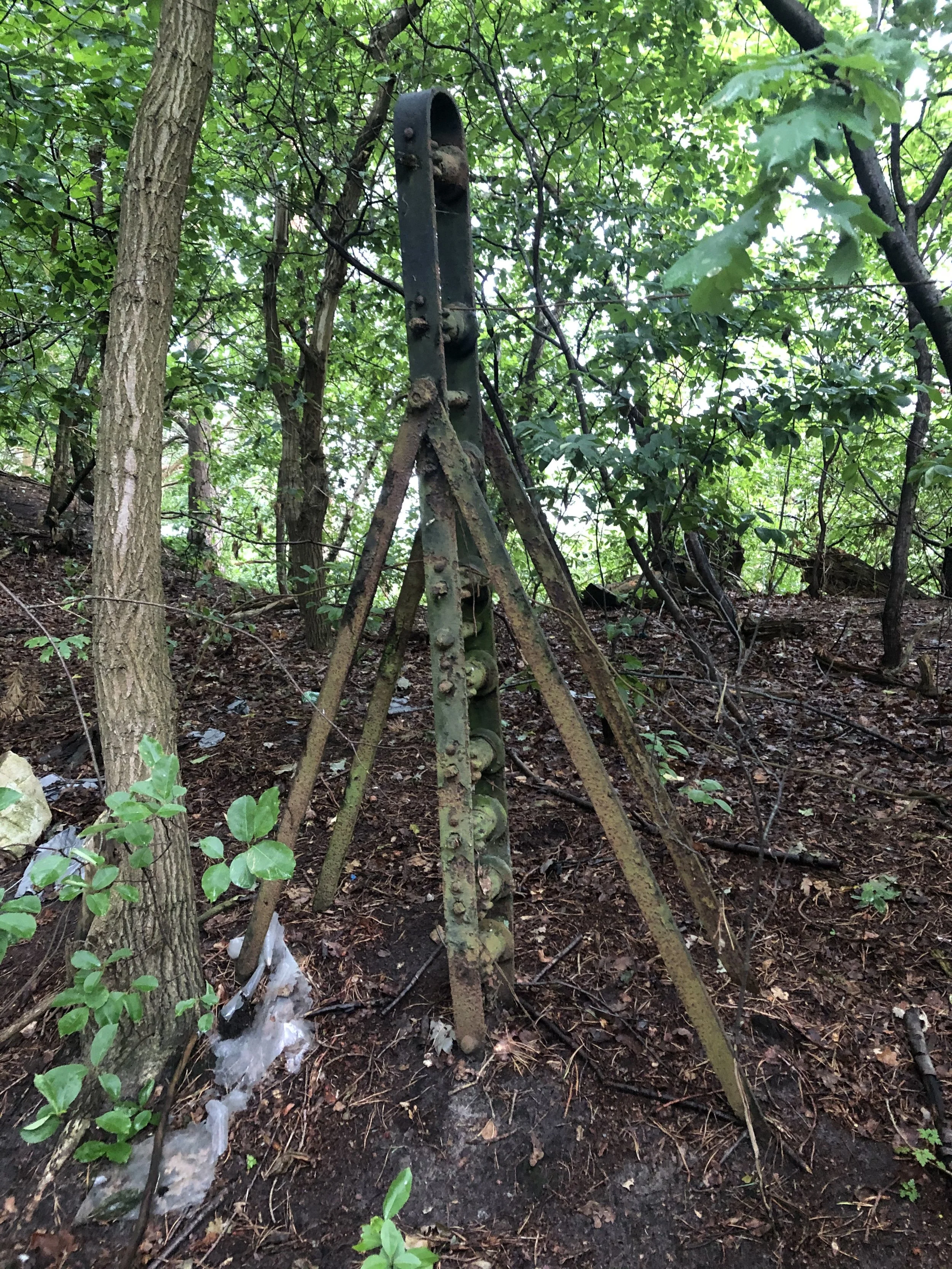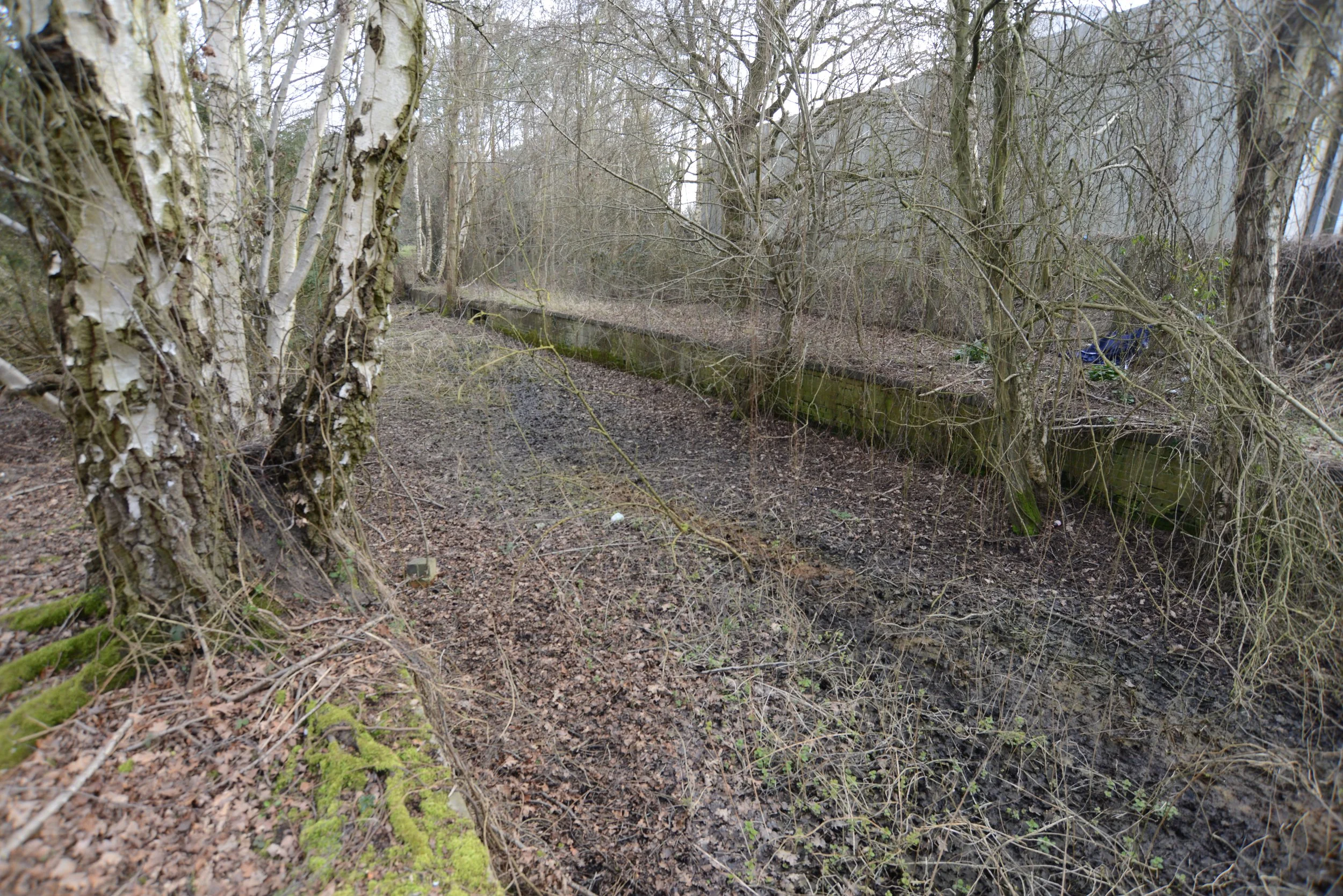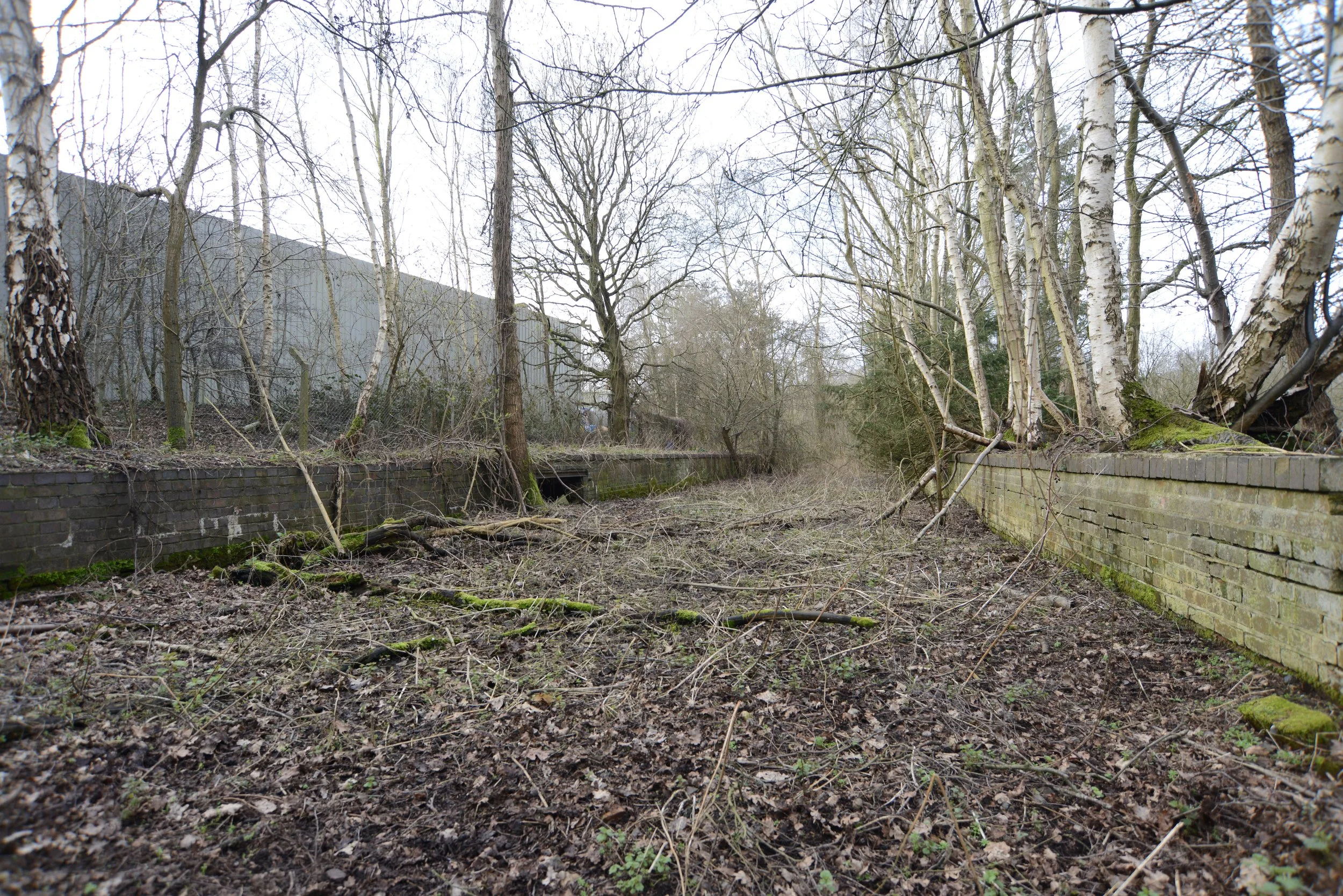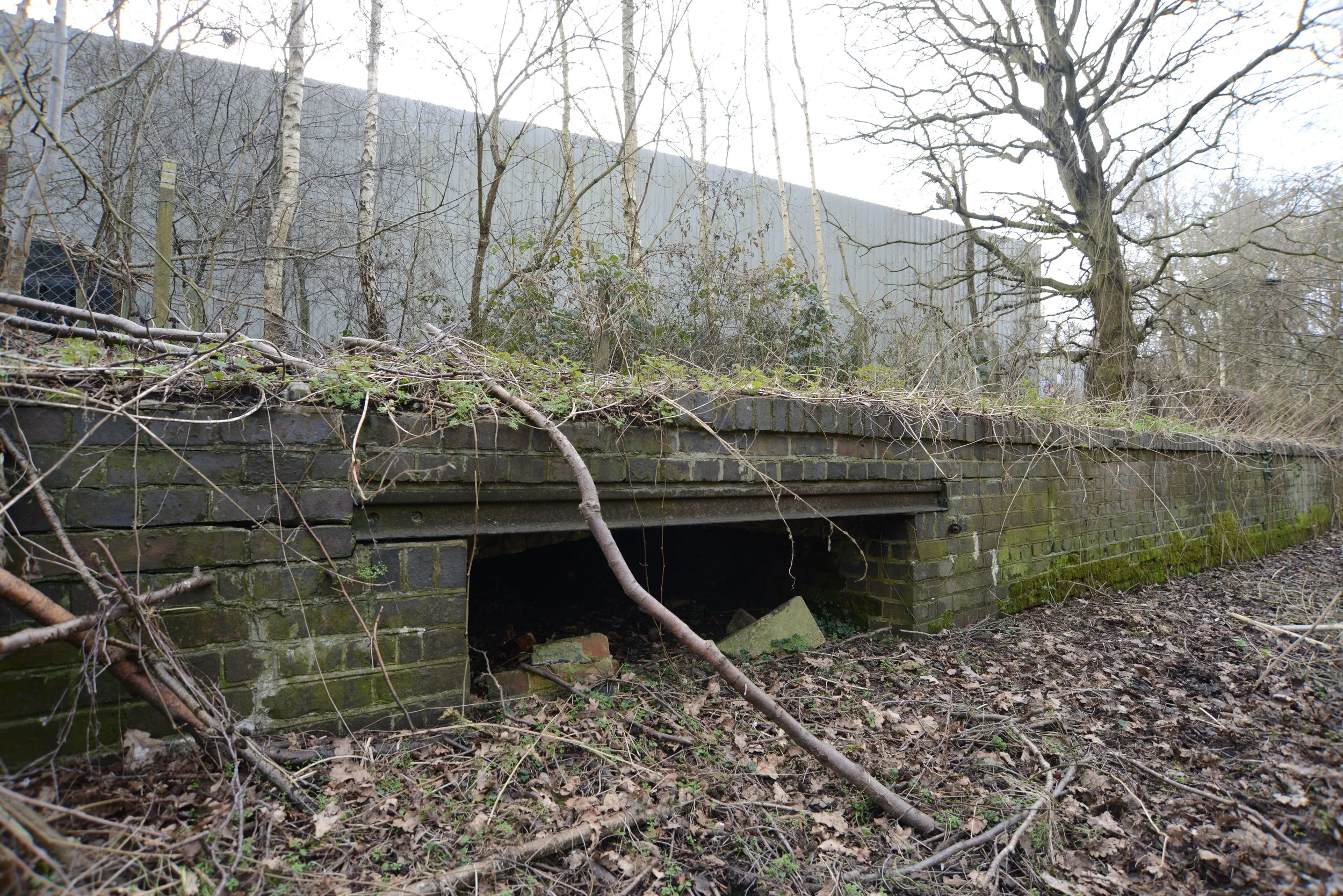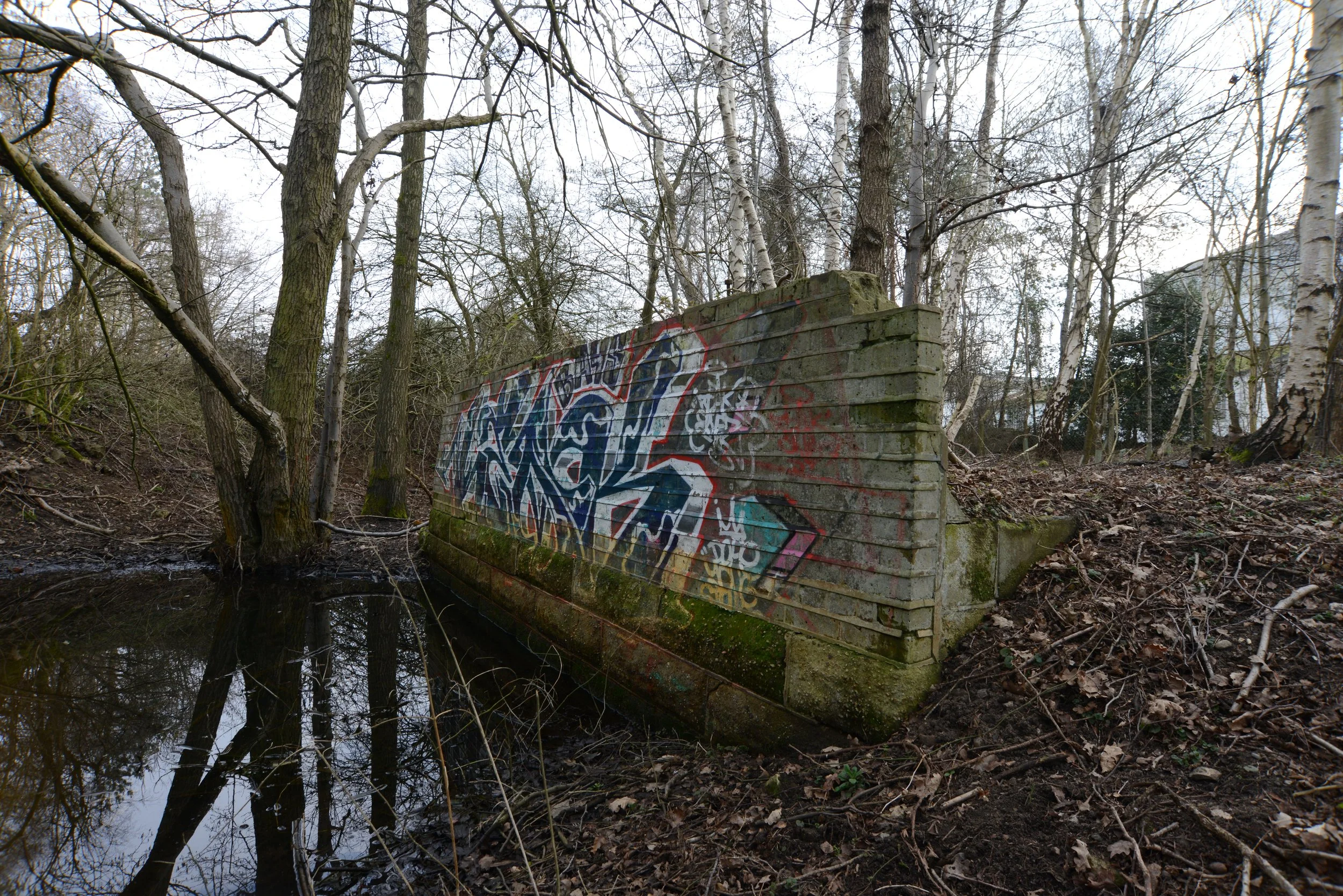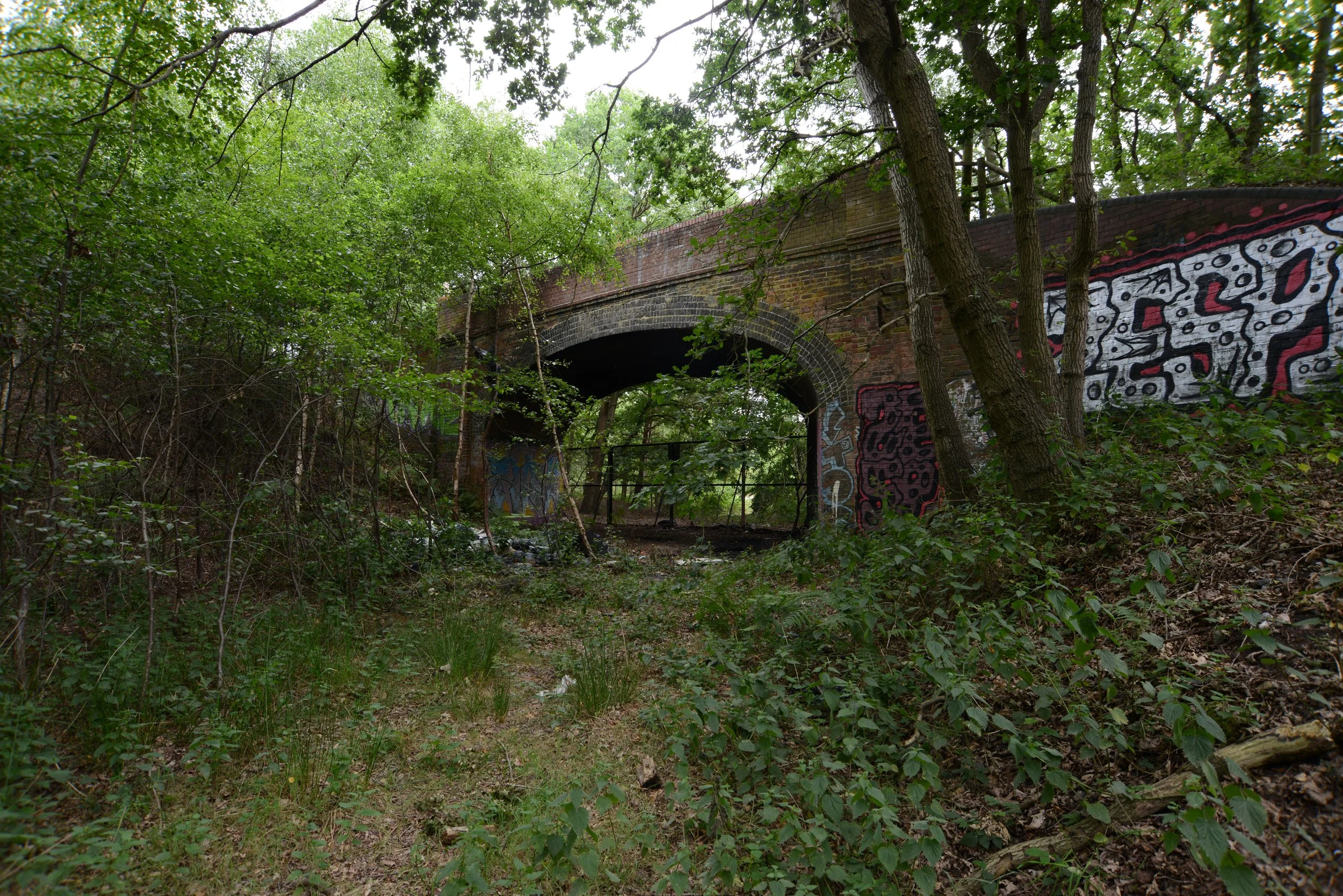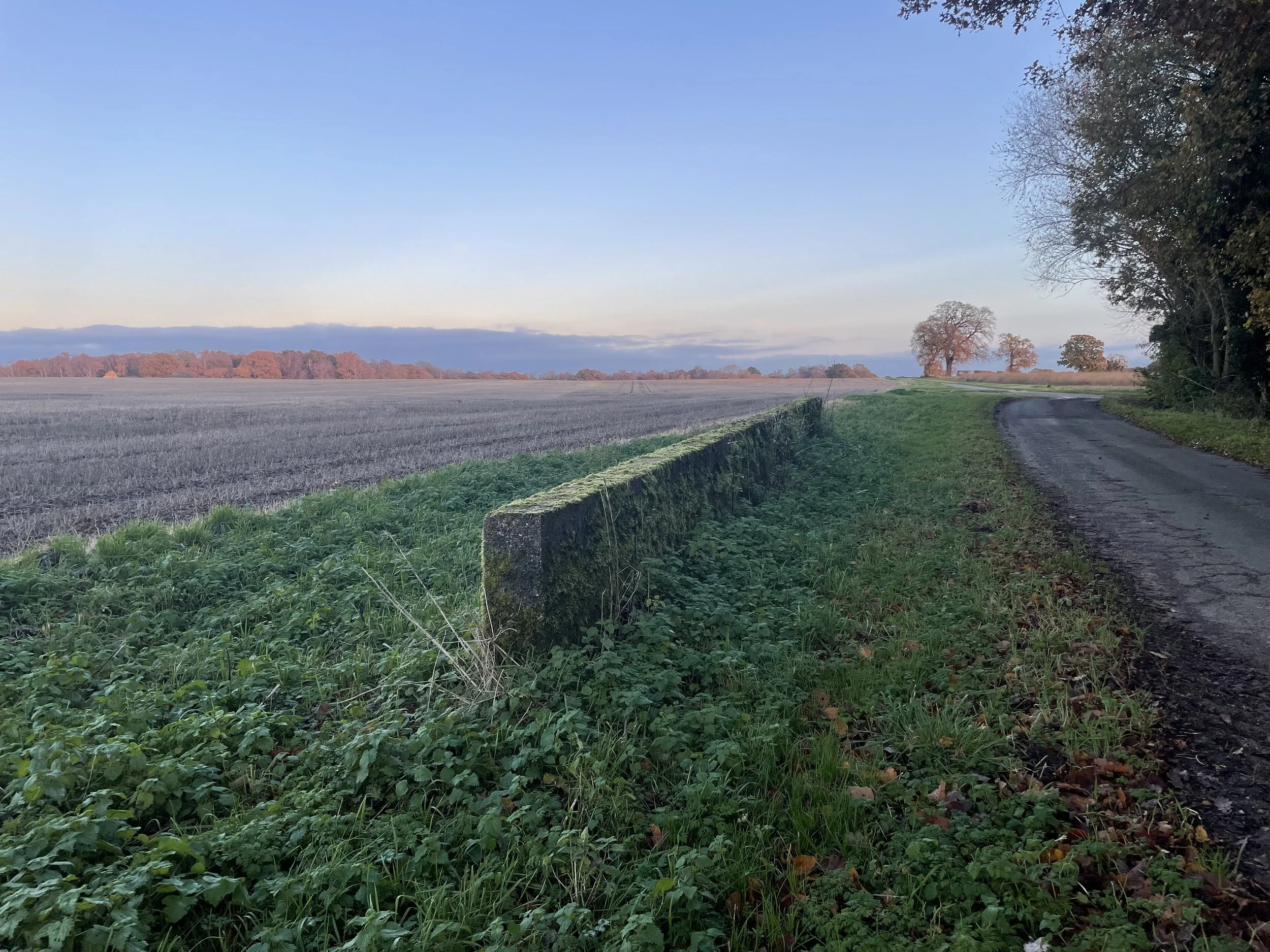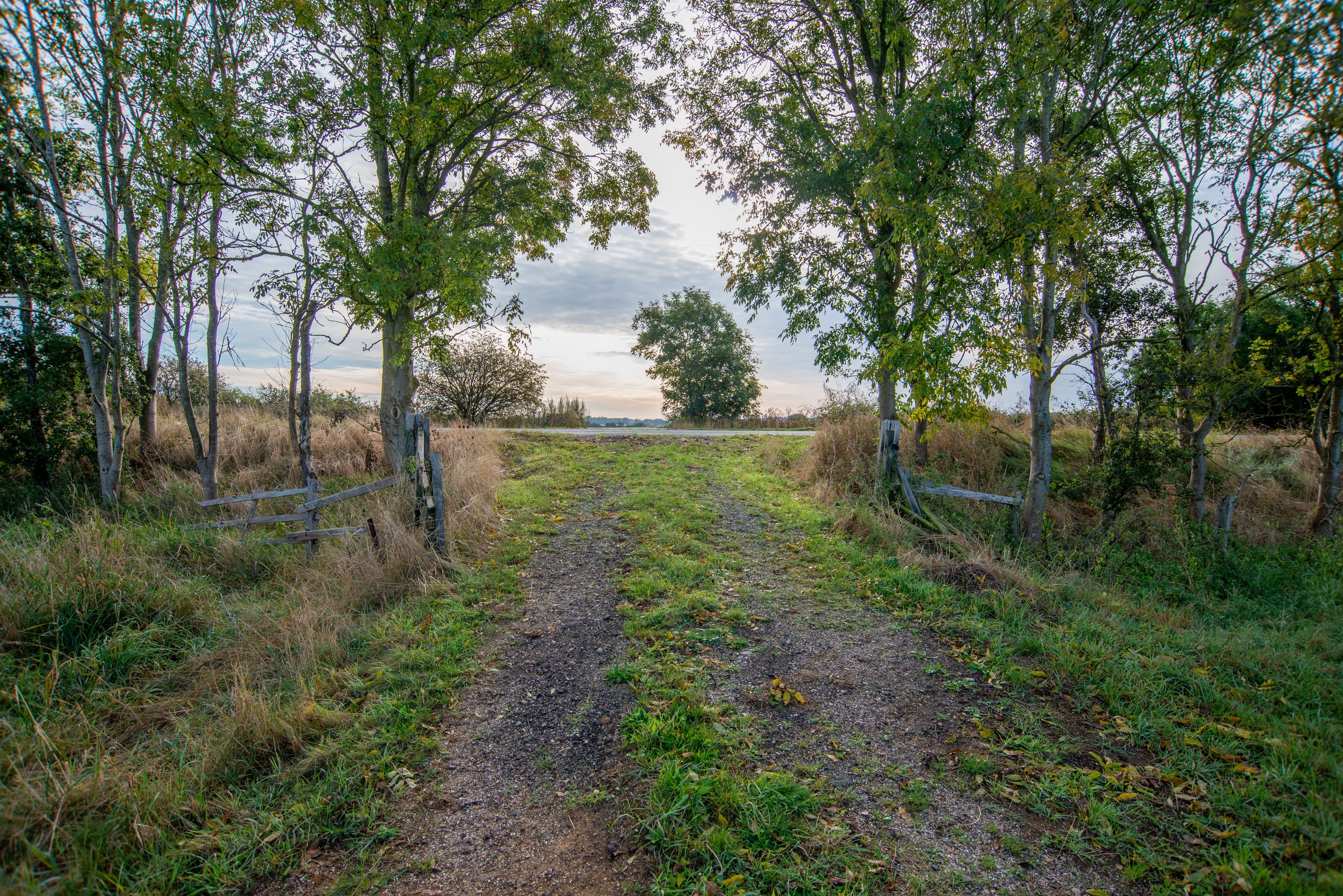
THE KING’S LYNN AVOIDING LINE
We recommend viewing this page on a desktop pc-laptop or tablet for a better viewing experience.
Welcome to my page about the King’s Lynn avoiding line, which includes sections on the Lynn Sutton Bridge railway and the Lynn Fakenham line, as well as featuring Cross Keys Bridge.
(Sutton Bridge)
In 1846, the Lynn Ely Railway opened, and in August 1861, the Lynn Sutton Bridge Railway, also known as the Bourne and Lynn Railway, was authorized by parliament. It opened in 1864 and is shown on historical maps as the Bourne and Lynn Railway. It started its services from the original wooden station in Kings Lynn, which was later replaced by a brick station built by Robert Skipper of Dereham in 1871, which still exists today.
Departing King's Lynn, the Sutton Bridge railway line used the Lynn Ely line and headed to the southern edge of the town to Harbour Junction. From there, the line diverted towards Sutton Bridge, with the next station being West Lynn. However, the single-platformed station at West Lynn was short-lived, and there is minimal historical information about this old station.
It is estimated to have been opened from 1866 to 1886 After West Lynn the line called at Clenchwarton, Terrington, and Walpole, before arriving at Sutton Bridge.
On the northern side of King’s Lynn, the King’s Lynn to Hunstanton railway line opened in 1862, and the Lynn Fakenham Railway opened in 1879 between Gaywood and Great Massingham. This is shown on historic maps as the Eastern & Midlands railway. The Lynn Fakenham line originally ran from a junction that branched off the Lynn Hunstanton Railway at Gaywood, between King’s Lynn and North Wootton. The line was extended to Fakenham in 1880, expanding further to Melton Constable, Great Yarmouth, Cromer, and Norwich City station and in later days all these became part of the M&GN.
The Lynn Fakenham railway called at Grimston Road, Hillington, East Rudham, West Raynham & Fakenham.
King’s Lynn was becoming very busy with the Lynn Ely Line (1846), the Lynn Dereham Line(1846), the Hunstanton Branch (1862), and the Wisbech-March branch (1848) that branched off the Lynn Ely Line at a junction at Magdalen Road (now called Watlington). Freight traffic was also present at King’s Lynn with the docks branch that opened in 1870 and headed towards the docks from King’s Lynn Junction, where the Lynn Hunstanton, Dereham, and Ely-Sutton bridge lines diverged onto their dedicated lines.
An initial plan proposed the construction of a new station on Austin Street in King’s Lynn. The envisioned railway line would have diverged from the Hunstanton line at a location known as Salters Road Junction, which is situated near the junction for the Lynn-Bawsey-Fakenham line. The line would have briefly utilized the Docks railway before continuing on its dedicated route to Austin Street. However, this line was never completed, saw no traffic, and was ultimately abandoned and dismantled.
A through route was needed to link the Lynn Sutton Bridge line up to the Lynn Fakenham line and to divert some traffic from the main King’s Lynn Town station and King’s Lynn Junction.
In 1885, the Lynn Loop was opened for freight, followed by passenger services in 1886. That same year, South Lynn Station was also opened for passenger use, coinciding with the closure of West Lynn Station. The new loop line ran from Bawsey and circled around King’s Lynn to the south side of the town, leading to the newly established South Lynn Station.
Along this new loop line, a station called Gayton Road was constructed and opened in 1887. Additionally, a new bridge was built to allow the loop line to cross over the Lynn-Dereham line between King’s Lynn and Middleton Towers. As a result, the previous connection from Gaywood Road Junction, located north of King’s Lynn, to Bawsey was closed.
The 3-mile and 22-chain route between Gaywood and Bawsey was kept intact for potential diversionary and excursion traffic, but it was ultimately removed as it was never utilized. Part of the old Sutton Bridge line at South Lynn continued to serve as a junction for shuttling trains from South Lynn Station to King’s Lynn Town Station. This included many excursion trains to the Norfolk coast via the Hunstanton branch until the M&GN closed in 1959. The junction remained operational for freight use until the late 1980s or early 1990s, serving the southern side of King’s Lynn and the nearby beet factory.
The Lynn Avoiding Line was the final connection that linked the eastern lines, which reached Norwich in 1882 and Cromer in 1887, directly to the lines west of King’s Lynn.
The Lynn & Fakenham Railway operated from 1876 to 1883. 1883 the Eastern and Midlands Railway was established, amalgamating the Yarmouth and North Norfolk Railway, the Lynn and Fakenham Railway, and the Yarmouth Union Railway. The Lynn Fakenham line was later managed by the M&GN until 1948.
The railways were nationalized and became British railways in 1948. The line was eventually closed in 1959. A small part to East Rudham was used for freight until 1967.
The Lynn Fakenham line once ran off the Lynn Hunstanton branch and is now the location of Lynn Sport, a leisure complex constructed over the junction's old position. I found two small buttresses from the old railway that still exist not far from the junction. Further along the railway, it would come up to Wootton Road crossing, where there is no evidence today that a crossing once existed there. Leaving Wootton Road, the line headed towards Bawsey, passing the side of the Gaywood River. Part of this area is still used as a farm track near the after-constructed A149 bypass and close to the Queen Elizabeth Hospital. The railway then followed along the side of the Gaywood River for a short time before heading through open fields passing a short distance from the 11th-century Saint James Church before reaching Bawsey, where the Lynn Loop was later constructed. Chilver House Lane now takes up a small part of the original track bed at Bawsey.
The Lynn Loop, starting from Bawsey, crossed a small bridge over the Gaywood River, then passed through what is now a scrap metal recycling yard before arriving at Gayton Road station a two-platformed station with a waiting room and station masters house and its dedicated signal box. The station remains, but it is overgrown and potentially boggy. Both platforms are still there, but all the buildings have been removed, and only a small part of the waiting room wall remains. The line then continued through Bawsey, which was later excavated for silica sand and is now used as Bawsey Country Park. passing under two bridges that still stand to this day the railway soon after entered a cutting. I discovered a buttress that was used as a railway crossing for a farm track, but the land on both sides has now been infilled. The railway continued, passing over the Lynn to Dereham railway. Part of this bridge remains and still has the buttresses on both sides with the overpass removed, and the Dereham line at this point is still in use for freight services towards Middleton Towers, passing over this bridge the Lynn avoiding line railway passed over a few small drain crossings.
Today, the old railway track bed at this point is used as a farm track.
The loop would have run around the edge of the after-constructed Hardwick Narrows industrial estate, crossing over the Lynn Ely railway via a bridge on a raised track bed. Shortly thereafter, it would pass over another bridge that spanned the River Nar. After this final bridge, the railway would cross a junction that once connected the Lynn Sutton Bridge railway from the Lynn Ely line at Harbour Junction. Soon after, the railway would head into South Lynn station.
Marking the end of the Lynn loop line
Nothing remains of South Lynn station; however, two bridges located just before the station that cross the river are still standing. One bridge was part of the Lynn Loop, and the other was part of the original Lynn Sutton Bridge line. The bridge from the old Lynn Sutton Bridge railway track may be the original or could have been replaced at some point in the railway's history. Additionally, a portion of the railway track that was once part of the Lynn Sutton Bridge railway track bed is still visible. This line was later used for the South Lynn to Lynn Town shuttle, which transported both passengers and freight from the M&GN at South Lynn to the Lynn Ely line. It continued to handle freight movements until the late 1980s and early 1990s. Although small sections of the track are still visible today, they are heavily overgrown.
Additionally, the bridge that once spanned the Lynn Ely line was demolished, along with one buttress on the Hardwick Narrows side and another buttress closer to South Lynn station remains, as does the raised track bed on the South Lynn side.
Much of the track bed from South Lynn to Sutton Bridge is now repurposed as the A17 bypass, and all the intermediate stations are no longer there all that remains is the cross keys swing bridge or Sutton Bridge that’s still in use carrying the A17 road traffic.
Maps
Historical maps
Bawsey to Gaywood junction
Pre Construction of the Lynn avoiding line.
Thanks to The National Library of Scotland for all the Maps used below
All maps below are dated from the 1830s to the 1880s
Maps from the 1830s to 1880s show the Lynn Fakenham line curving at Bawsey and heading towards King’s Lynn Town station.
The Historic maps indicate the line as the Eastern & Midlands railway.
© 2024 National Library of Scotland
Maps from the 1830s to 1880s show the Lynn Fakenham line curving at Bawsey. A combination of a historical and modern maps illustrates the starting point of the Lynn avoiding line, showing the tree line where the Lynn avoiding line ran to South Lynn before its closure. Additionally, the bottom of the map shows Gayton Road, where the new station was built.
© 2024 National Library of Scotland
The railway headed off towards King’s Lynn through farmland and across fields where the A149 was constructed many years after the removal of the line.
Click the link below for where the line would have crossed over a field that’s now the A149 and off towards Kings Lynn part of the track bed on Google Maps looks visible and is now used as a farm track.
At Wootton Road, I was looking at historic maps and it seemed there used to be a level crossing at this location. Please click the Google Street View link to view the location.
© 2024 National Library of Scotland
Gaywood junction joined onto the King’s Lynn to Hunstanton Railway that would have taken the Lynn Fakenham line into King’s Lynn station during the early days.
© 2024 National Library of Scotland
A view from a 50-50 perspective of the point where the disused railway line joined the King’s Lynn to Hunstanton line at Gaywood. Also, visible is Wootton Road crossing. Additionally, the housing built over the old track bed shows that there are no longer any remnants of the old railway line in this area with Lynn Sport also built over where the junction once was.
© 2024 National Library of Scotland
Historical maps
South Lynn
Pre construction of the Lynn Loop.
Thanks to The National Library of Scotland for all the Maps used below.
All maps below are dated from the 1830s to the 1880s
Maps from the 1830s to the 1880s show the line at South Lynn From Kings Lynn town station heading off towards Sutton Bridge at Harbour Junction with no Lynn avoiding line installed.
Also, no station at South Lynn existed at the time of these maps.
Although West Lynn existed on this map.
© 2024 National Library of Scotland
Historical maps
Gaywood junction to Bawsey
After construction of the Lynn avoiding line.
Thanks to The National Library of Scotland for all the Maps used below
Maps from the 1892 to 1914 Kings Lynn Loop line taking the now M&GN line from Fakenham and Melton Constable off towards South Lynn Eliminating rail traffic needing to use King’s Lynn Town station.
The old Gaywood Junction line here is seen as Abandoned.
Also seen on the historic map are some sidings at Bawsey
To this day there are no signs of the Junction and its said to be very over grown.
© 2024 National Library of Scotland
Maps from the 1892 to 1914 the line at what was Gaywood junction along the King’s Lynn to Hunstanton Railway.
Again the old line is showing abandoned
© 2024 National Library of Scotland
Historical maps
South Lynn
After construction of the Lynn avoiding line.
Thanks to The National Library of Scotland for all the Maps used below
All maps below are dated from 1892 to the 1914
Maps from 1892 to 1914 show the railway line at South Lynn with the Lynn avoiding line. They demonstrate how the services, now on the M&GN, entered what was formerly the Lynn & Sutton Bridge Railway and then continued into South Lynn Station. This change eliminated the need for trains to enter Lynn Town station.
On the map below, you can also see the location of the curved section in the railway, which was formerly part of the Lynn Sutton Bridge Railway. This section was preserved and then served as a junction for shuttle services between South Lynn and King’s Lynn town bringing many services off the M&gn and off to Hunstanton.
© 2024 National Library of Scotland
Later maps indicate that the area at South Lynn has been more utilized for industrial sidings.
© 2024 National Library of Scotland
M&GN Network map
MY GOOGLE MAPS
My Google Maps with the Lynn to Fakenham railway and the Lynn Sutton Bridge Stations in Blue with the M&gn connection stations in Green with the Lynn loop stations in Black.
This website is made up of three parts
Part one
The Lynn To Fakenham Railway via Gaywood Junction & Bawsey
Part two
The Lynn to Sutton Bridge Railway
Part three
The Lynn avoiding line

The Lynn To Fakenham Railway via Gaywood Junction & Bawsey
Part One
King’s Lynn station
The King’s Lynn town station was originally built in 1846 as a wooden structure and was rebuilt in 1871 to the station we see today. The Sutton Bridge railway started at the wooden station when the line opened in 1864, and the Fakenham line opened in 1879 after the new brick station was constructed. The Lynn to Fakenham and the Lynn to Sutton Bridge railways had a short life at this station before the avoiding line was constructed, and then the new out-of-town station at South Lynn was used.
This became the new station for the Sutton Bridge and Fakenham railways, soon to be the M&GN.
Additionally, King's Lynn also had services towards Dereham, Hunstanton, Wisbech, and March via a junction at Watlington.
This station is still in use to this day with hourly services towards London King’s Cross.
King’s Lynn station can be seen in the distance. The railway line running off towards the left is the Lynn to Hunstanton Railway, which went to Gaywood Junction and then to Fakenham.
The line to the right is the route that went to Ely, Cambridge, London, and Harbour Junction, where the Sutton Bridge line originally departed from King’s Lynn.
The Lynn Dereham line runs straight ahead. After the construction of the Lynn Loop, the Lynn Dereham Railway would have passed underneath the Lynn Loop, which crossed over the Lynn Dereham line.
The town centre, King's Lynn, 1950 © Historic England. Aerofilms Collection EAW031883 flown 14 August 1950
Please click on the photo for a link to the source page.
Destination board at King’s Lynn with M&GN South Lynn destinations displayed at the bottom.
Sourced via Facebook Photographer unknown
King’s Lynn station today
This station was constructed in 1871
Creative Commons CC0 1.0 Universal Public Domain Dedication Lewis Collard
Kings Lynn Junction
In previous years, King's Lynn junction had the Hunstanton branch on the left, leading towards Gaywood Junction, while the line to Ely was to the right. In its early days, the line also extended towards Sutton Bridge. By the time these photos were taken, the Lynn Avoiding Line would have already been completed many years prior.
This photo shows a freight service arriving from the Lynn Dereham line.
Year and photographer unknown
King’s Lynn Junction in 2020: the line to the left is the Lynn to Ely main line, and the line ahead is the Lynn to Middleton Towers freight line. The Hunstanton Branch line has long disappeared here.
Here we can see where the Hunstanton line would have run from the King's Lynn junction before it was sadly closed. However, I couldn't find any trace of the old track bed for the Hunstanton trains. This photo was taken in December 2020.
Heading to Gaywood Junction
After King’s Lynn The Lynn Fakenham Line followed the Lynn Hunstanton Line bearing to the left heading to the Gaywood road crossing and the Gaywood Junction.
Below we see a Royal engine just after leaving King’s Lynn and heading to Wolverton.
©year and photographer unknown
The old track bed has been repurposed into a public foot path.
Gaywood road level crossing
During the historical days of the Lynn Fakenham railway, there was a level crossing open at Gaywood Road. This can be seen on the historic map below, with the orange marker indicating the position of the level crossing and Gaywood Junction located at the top of the map.
© 2024 National Library of Scotland
Gaywood crossing seen in 2020 all thats remains is the crossing cottage.
Salters road crossing
Historical maps indicate that there was once a railway crossing at Salters Road in King's Lynn. However, very little information is available regarding whether this crossing was manned or unmanned, or when it was operational. The crossing spanned the Lynn-Hunstanton Railway between Gaywood Junction and Salters Road Junction. Maps from the 1830s and 1880s show that the crossing was in use during the operation of the Lynn-Fakenham Railway while utilizing Gaywood Junction.
Originally, Salters Road crossed over the Lynn-Hunstanton branch, but it now ends at Lynn Sport. The remaining portion of the road can be found across the North Lynn housing estate, just off Columbia Way, on the opposite side of the housing estate.
Maps dated 1830s 1880s
© 2024 National Library of Scotland
The historical maps from the 1830s to the 1880s indicate that there was a short-lived signal box in this area. Given the presence of the Gaywood junction, it is highly likely that a signal box existed here. Additionally, this location marks the site of the first milepost.
© 2024 National Library of Scotland
Maps dated 1888 1915
© 2024 National Library of Scotland
Maps dated 1888 1915
© 2024 National Library of Scotland
Maps dated 1830 to 1880 with a 60/40 split
© 2024 National Library of Scotland
Modern maps
©Googlemaps
Salters Road photographed in modern times would have been where the railway crossing would have been in the past.
Salters road junction
The Hunstanton line was initially linked to another railway line constructed by the Lynn and Fakenham Railway Company. This connection branched off in the opposite direction of the Lynn and Fakenham Railway line, heading toward the Docks line and continuing to a proposed new station at Austin Street. The junction was situated near the point where the Lynn and Fakenham Railway originally diverged, which led towards Bawsey.
The line ran for approximately half a mile to the Docks railway, using this section of track for a short distance before diverging onto a separate line that would have provided access to the new station at Austin Street in King’s Lynn. However, this line was never fully constructed and reportedly remained untouched for a considerable period before being abandoned and dismantled and becoming part of Rope walk.
It has been said that the old station building was used as a railway office for a short time before being demolished.
Today, the only remnant of this line is a crossing cottage located on Loke Road, near the College of West Anglia.
Part of the track bed remains clear and is now used as an access road to units near North Lynn, while the land closer to the old track bed near Lynn Sport has been developed into housing.
Historic maps from the National Library of Scotland, dated 1888-1915, show the abandoned railway at King’s Lynn.
© 2024 National Library of Scotland
Historic maps from the National Library of Scotland, dated 1892-1914, show the abandoned railway at King’s Lynn.
© 2024 National Library of Scotland
Historic maps indicate the planned location of the railway line between the Docks railway and Austin Street. However, the exact site of the railway station on Austin Street remains unknown to me.
© 2024 National Library of Scotland
What seems to be the crossing cottage on Loke road at King’s Lynn
Gaywood junction
Gaywood Junction was once a key point on the Lynn-Fakenham line, which diverted toward Bawsey and then Fakenham from the Lynn-Hunstanton branch line. This diversion occurred before the construction of the Lynn avoiding line. Additionally, another junction, Salters Road Junction, was established near Gaywood Junction to redirect services to a proposed new station at Austin Street. However, this new station was never used, and Salters Road Junction also remained unused.
Today, there are no signs of the railway junction at Gaywood Junction, as the area has been transformed into a sports complex known as Lynn Sport.
© 2024 National Library of Scotland
50/50 maps with Lynn Sport and also showing Gaywood Junction.
© 2024 National Library of Scotland
Historic maps showing Salters road and Gaywood Junctions.
© 2024 National Library of Scotland
Lynn Sport in 2024, and yes, that is a Batmobile and a Scooby-Doo van in the background. This building was constructed where the Junction once laid.
Lynn Sport Complex viewed from the old Lynn To Hunstanton Track bed now used as a public footpath.
Lynn Sport Minature railway
Off to Fakenham
Disused railway bridge
The first discovery on this abandoned long lost route so far is this old bridge that carried the railway over the Bawsey drain at what is now Lynn sport close to the Gawood Junction.
Photographed in 2024
Wootton road crossing
Shortly after the small river crossing the railway crossed over Wootton road
Photographed in 2024
"The maps below depict the railway in use and after its closure."
© 2024 National Library of Scotland
© 2024 National Library of Scotland
Wootton Road in King’s Lynn, where the railway would have crossed a very different-looking scene many years ago.
After the crossing, the railway headed off towards Bawsey through the open Country side.
© 2024 National Library of Scotland
The old track bed is still in use as a popular walking route up to the A149 for dog walkers. This footpath has been nicknamed the "cockle shell path" because it is made up of old cockle shells in many places.
Looking towards Wootton road crossing the railway roughly ran through the over growth.
These photos were taken in September 2024
Off Down the “Cockle shell path” heading towards the A149 alone the old track bed that once went onto Bawsey then to Fakenham.
Looking back towards King’s Lynn from the A149
Looking towards Bawsey we arrive at the end of what’s left of the old track bed we arrive at the A149 Bypass.
Facing towards Bawsey, the railway would have passed across this field before it headed off towards Fakenham.
Standing on the opposite side of the bypass, facing towards the Cockle Path and King’s Lynn.
50/50 map coverage of where the railway track bed is, with the Bypass constructed many years after the closure of the railway.
© 2024 National Library of Scotland
This is how far i have managed to investigate the Lynn Bawsey Fakenham line the junction at Bawsey is said to be reachable but very over grown.

The Lynn to Sutton Bridge Railway
Part 2
Leaving Lynn Station, the railway headed towards Harbour Junction. At Harbour Junction, the Sutton Bridge line would branch off from the Lynn Ely line and proceed towards Sutton Bridge on its dedicated route. The stops along this line would include West Lynn, Clenchwarton, Terrington, and Walpole before arriving at Sutton Bridge.
When I wrote this page, all that remained of the Lynn Sutton bridge railway was a bridge and some small parts of the railway track close to Harbour Junction. I'm unsure if the bridge was original or replaced over time. All stations along the route have been demolished, with only a small memorial at Walpole dedicated to the long-lost railway. The track bed was repurposed into the A17 bypass, which pretty much follows the old track bed. At Sutton Bridge, the Swing bridge called Cross Keys Bridge still exists and is in daily use, carrying A17 road traffic over the River Nene.
The river Nene leads into Wisbech Docks and also serves Sutton Bridge docks.
Lynn Sutton Bridge railway Track bed & Bridge
Leaving King’s Lynn the line went off towards Sutton Bridge and leaving the Lynn Ely line the railway headed south along the track bed seen below and over a railway bridge that crossed the river Nar.
The original track bed from the Lynn Sutton Bridge railway was then incorporated into the Lynn avoiding line. It was used as part of Harbour Junction to shuttle trains from South Lynn to King’s Lynn Town station and also to transfer holiday special trains from the M&GN at South Lynn to Hunstanton. It is unclear when this line stopped being used. However, it was still in use long after the M&GN closed, primarily for transporting freight.
© 2024 National Library of Scotland
The track lay out after the Lynn avoiding line was built
© 2024 National Library of Scotland
Leaving the Lynn Ely line the railway headed off towards West Lynn then Sutton Bridge going along this old track bed at South Lynn that was photographed over the easter weekend of 2023
Chances are this track is not the original track, but it is on the exact same track bed and trajectory.
The date stamp indicates that the track and fittings have been unsurprisingly replaced since the Lynn Sutton Bridge line.
The South Lynn River crossing bridge
The Lynn Sutton Bridge line would cross the river using this bridge or possibly an earlier one. , this bridge was used to connect the Lynn Ely line to the M&GN after building the Lynn-avoiding line. It was located just after the remaining track, as seen above. There isn't much information available, and it's unclear whether this was the original bridge from the Lynn Sutton Bridge line or if it was replaced during the construction of the Lynn Avoiding Line. If you have any information, please feel free to get in touch.
The Maps below show the position of the bridge before and after the construction of the avoiding in a past and present form.
The Lynn Sutton Bridge line would cross the river using this bridge or possibly an earlier one. Later, this bridge was used to connect the Lynn Ely line to the M&GN after building the Lynn-avoiding line. It was located just after the remaining track, as seen above. There isn't much information available, and it's unclear whether this was the original bridge from the Lynn Sutton Bridge line or if it was replaced during the construction of the Lynn Avoiding Line. If you have any information, please feel free to get in touch.
Shortly after this bridge the line would have arrived at South Lynn station
Another webpage about this bridge and the surroundings of South Lynn can be found on the webpage where I originally discovered the existence of these bridges.
Please click the link below.
South Lynn Station
South Lynn station was built after King’s Lynn town station, which was constructed in 1846. The next station along the Lynn Sutton Bridge railway was West Lynn, located on the western side of the River Ouse. West Lynn station was closed in 1866, and with the construction of the Lynn avoiding line, South Lynn station opened in the same year.
In its later days, South Lynn served M&GN and also had numerous freight sidings constructed over time to supply various industrial companies in the vicinity. South Lynn had two passenger platforms and closed in 1959.
To this day, nothing remains of South Lynn station. Most of the land the station stood on is still wasteland, with a small portion taken up by the A47 dual carriageway.
It has been said that one of the reasons for South Lynn's closure was that the bridge carrying the railway over the River Ouse just west of the station was beyond repair and not financially viable.
© 2024 National Library of Scotland
The Free Bridge, Railway Bridge and South Lynn Station, King's Lynn, from the north-west, 1932 © Historic England. Aerofilms Collection EPW039193 flown July 1932
Please click on the aerial image for the Source page
Photographer and year unknown
Ben Brooksbank / Ex-GE B12/3 4-6-0 on Rail Tour at South Lynn / CC BY-SA 2.0
©Photographer and year unknown
Off to Sutton Bridge
Leaving King’s Lynn between 1864 and 1886, and South Lynn between 1886 and 1959 the railway headed off to Sutton Bridge the railway called at West Lynn pre Lyn Loop days 1866 to 1886 then after the railway called at
Clenchwarton
Terrington
Walpole
Sutton Bridge
The railway closely followed the path of the current A17 bypass, and no stations still exist. The only remnants of the railway are a memorial at Walpole and Cross Keys Bridge (Sutton Bridge). One of the primary reasons for the closure of the M&GN Railway was the need for major repairs on the River Ouse bridge, which would have been very costly to fix.
River Ouse Crossing
Leaving the South Lynn area, the railway crossed over the River Ouse via a bridge considered unsafe in the later days of the railway. This was one of the rumoured reasons for the early closure of the M&GN in the late 1950s.
© 2024 National Library of Scotland
The map below shows the old river crossing as dismantled
© 2024 National Library of Scotland
West Lynn Station
West Lynn station was operational during the early days of the Lynn Sutton Bridge railway. It was the next station after the main station in King’s Lynn. West Lynn station was a simple, one-platform station, and the history of this long-lost station is quite limited.
Once the Lynn avoiding line and South Lynn were constructed. West Lynn station was closed.
1866-1886
© 2024 National Library of Scotland
60/40 map coverage of where West Lynn station once stood.
© 2024 National Library of Scotland
Rough location of West Lynn station
Walpole Memorial
Close to the A17, this small memorial commemorates the M&GN and Lynn Sutton Bridge railway station.
Cross Keys Bridge
The Cross Keys bridge that we see today was the third bridge built to cross the river Nene at Sutton Bridge. The first bridge opened in 1831, and the replacement bridge opened in 1850. The second bridge was a swing bridge, similar to the one we see today. From 1850, the bridge was used for road traffic only, until 1864 when the railway also acquired rights to use it.
The present bridge, which still stands today, was constructed in 1897 for £80,000. It was originally hoped that the 1850 bridge could be kept for rail use, but it was considered a hazard, so it was demolished.
The westbound carriageway was for railway use, while the eastbound lane was used for road traffic until 1965, when the railway closed to freight use. The bridge was then converted to the road crossing we see today, carrying A17 traffic over the river Nene.
Thanks to the National Library of Scotland, the historic maps below shows the Cross Keys Bridge layout during the railway era.
© 2024 National Library of Scotland
Historic maps below show the railway has been removed, and the A17 at this point has not been redirected to run along the old track bed alignment. Also, the A17 runs through Sutton Bridge down Bridge Road.
© 2024 National Library of Scotland
The Sutton Bridge maps have a split view displaying historic maps and modern-day maps. They show that the A17 used to follow a different route, whereas now it runs along the old track bed of the Lynn Sutton Bridge railway. On the opposite side, where the railway was formerly located, there is now an industrial unit. The access road to Bridge Road has also been altered because of the removal of the old railway.
© 2024 National Library of Scotland
Modern map coverage
© Google maps
Historic Aerial photos
Cross Keys Swing Bridge, Sutton Bridge, 1932. This image has been produced from a copy-negative. © Historic England. Aerofilms Collection EPW039205 flown July 1932
Please click on the photo for the Source page
Bridge Road and environs, Sutton Bridge, from the south-east, 1932 © Historic England. Aerofilms Collection EPW039204 flown July 1932
Please click on the photo for the Source page
Historic Photos
©facebook Lincolnshire railways
Modern Photos
Photographed in 2021
Underneath the bridge
Construction Plaque

PART 3
THE LYNN AVOIDING LINE
The Lynn Avoiding line was built to divert traffic from the main King’s Lynn station by connecting the Lynn Sutton Bridge railway and the Lynn Fakenham Railway along a new route to South Lynn. Eventually, it became part of the M&GN.
The Lynn avoiding line was opened in 1886.
Gaywood river bridge
This small bridge was constructed for the Lynn avoiding line, just after the Bawsey Junction.
Track bed & Fence
This is where the Lynn loop once ran The old track bed is now used for skip storage.
Part of the old fence found on the embankment by the Sandboy pub
Gayton road station
Gayton Road station was built as part of the Lynn avoiding line and started operating in 1887, one year after South Lynn.
It ceased operating for passengers in 1959.
Credit for the photos above via Alex Brammer @Gayton Road Railway Station Regeneration Project (M&GN) Facebook group
Gayton Road station photographed in March 2021
Railway Bridges
This second bridge is located a short distance from the former Gayton Road station site.
There is also another bridge sited shortly after this one that’s on private land and I have been unable to acquire photos.
If you have any photos you would like to donate, please feel free to contact me. Full credit will be given.
This small bridge, once part of a farm crossing, has been infilled many years ago. All that remains is this small part of the road crossing.
© 2024 National Library of Scotland
The Next Bridge carried the M&GN South Lynn to Fakenham railway over the King’s Lynn to Dereham railway.
Credit Alex Brammer from Middleton Towers Restoration Group
The next two images were provided by Steve Heywood from the Midland & Great Northern Joint Railway M&GN Facebook Group.
Thanks lots Steve.
Close to South Lynn station, there is an overpass bridge that was constructed for the Lynn avoiding line and crossed over the Lynn Ely Line. When I visited, all that remained was this one buttress.
The raised track bed at South Lynn that was part of the Lynn avoiding line.
The Last Railway Bridge near South Lynn station was built for the Lynn avoiding line and still exists today along the Nar Valley Way walk.
M&GN Bridge PmY2-53
Shortly after crossing over this bridge, the Lynn Avoiding line reached its destination, South Lynn.
THANKS FOR LOOKING
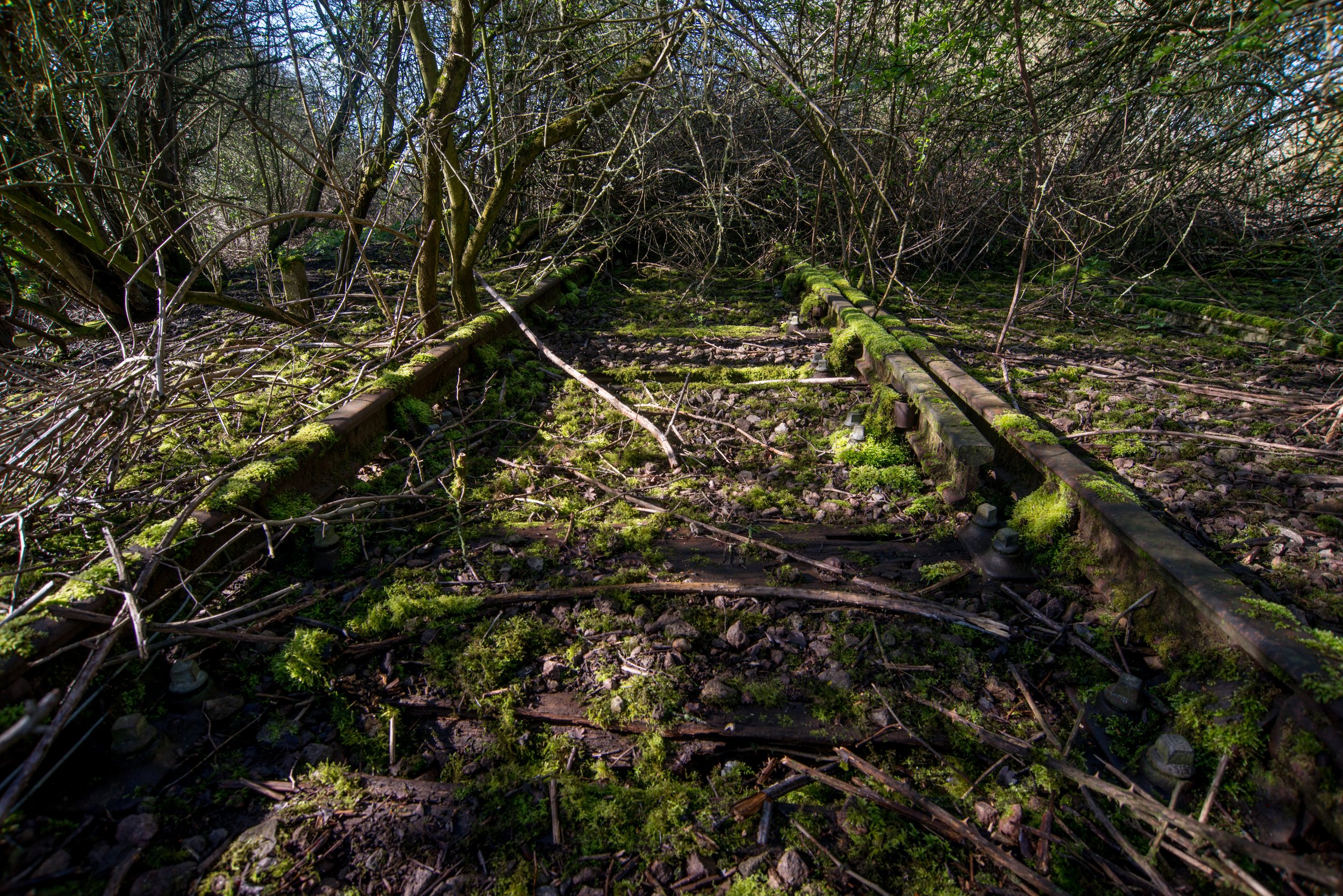
For more information on This Line and the Harbour Junction, click the links below. Also, a big thank you to Alex Brammer from the Middleton Towers Restoration Group and Steve Heywood for generously donating some photos.




















